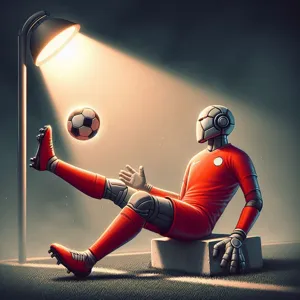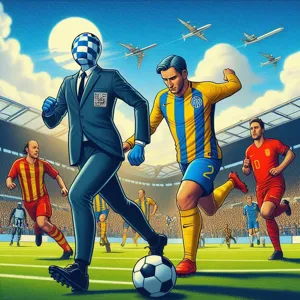In recent years, the world of soccer has been shaken up by a technological innovation that has sparked heated debates among fans, players, and pundits alike: the Video Assistant Referee, or VAR.
Designed to enhance the accuracy of officiating and reduce human error, VAR has been heralded as a game-changer for the sport, promising to bring fairness to pivotal moments of play. However, as it has been implemented in leagues and tournaments around the globe, it has also drawn fierce criticism for disrupting the flow of the game, causing lengthy delays, and, at times, leading to contentious decisions that leave spectators puzzled. In this blog post, we will explore the dual-edged sword of VAR—examining how it is reshaping the beautiful game and questioning whether it is truly preserving the spirit of soccer or ultimately undermining the very essence of what makes the sport so beloved. Join us as we delve into the heart of this ongoing controversy and seek to understand the profound implications of technology in a game steeped in tradition.
1. Introduction to VAR: What is it?

Video Assistant Referee, commonly known as VAR, has emerged as one of the most transformative—and contentious—innovations in the world of soccer. Introduced to enhance the accuracy of officiating during matches, VAR utilizes advanced technology to review key decisions made by on-field referees. This system employs a team of video assistant referees who monitor the action from a centralized location, analyzing footage from multiple camera angles in real time.
The primary purpose of VAR is to address clear and obvious errors in crucial moments, including goals, penalty decisions, direct red card incidents, and cases of mistaken identity. By providing referees with the opportunity to revisit critical calls, VAR aims to minimize the impact of human error on the game, ensuring that the outcome reflects the true nature of the play.
However, the introduction of VAR has sparked intense debate among players, coaches, and fans alike. While some argue that it brings much-needed precision to the sport, others feel that it disrupts the flow of the game and undermines the emotional intensity that defines soccer. The use of technology in a sport steeped in tradition raises significant questions: Is VAR preserving the integrity of the game, or is it stripping away its spontaneous essence? As we delve deeper into this discussion, it’s important to explore both sides of the VAR debate—the potential benefits it offers and the challenges it presents to the beautiful game.
2. The Origins of VAR: How It All Started
The origins of Video Assistant Referee (VAR) technology can be traced back to a growing desire for accuracy and fairness in soccer. As the game evolved, so did the scrutiny of officiating decisions, particularly in high-stakes matches where a single call could change the outcome of a tournament. The first seeds for VAR were sown in the early 2010s, spurred by advancements in technology and a series of controversial refereeing decisions that sparked heated debates among players, coaches, and fans alike.
In 2012, the International Football Association Board (IFAB), responsible for the laws of the game, began experimenting with video technology in lower-profile matches. Initial trials took place in countries like the Netherlands and Italy, where the focus was on assessing the feasibility of using video replays to assist referees. The positive reception and promising results from these pilot programs laid the groundwork for further exploration.
By 2016, VAR gained significant traction during the FIFA Club World Cup, where its implementation was closely monitored. The system aimed to assist referees in three key areas: goals, penalty decisions, and direct red card incidents. The initial trials showcased the potential to rectify clear and obvious errors, leading to a broader commitment to integrating VAR into the game.
The pivotal moment came in 2018 when VAR made its grand debut at the FIFA World Cup in Russia. The tournament marked a watershed moment for the technology, with referees making crucial decisions after consulting video footage. This integration was met with mixed reactions; while some celebrated the increased accuracy, others lamented the disruptions to the natural flow of the game. The debate over VAR’s impact on soccer had officially begun.
As VAR continues to evolve, its origins remind us of the delicate balance between embracing technology and preserving the spirit of the sport. Soccer, a game steeped in tradition, now finds itself at a crossroads, navigating the challenges and opportunities that come with this revolutionary yet controversial technology.
3. Understanding How VAR Works in Soccer

To fully grasp the impact of Video Assistant Referee (VAR) technology on the beautiful game of soccer, it’s crucial to understand how it operates. VAR was introduced as a means of enhancing the accuracy of officiating by providing referees with video footage that can assist in making pivotal decisions during a match. The technology is designed to intervene only in four specific scenarios: goals, penalty decisions, direct red card incidents, and cases of mistaken identity.
At its core, VAR functions through a dedicated team of officials stationed in a remote video operation room, equipped with multiple camera angles capturing every moment of the match. When a contentious decision arises, the on-field referee can either initiate a review by communicating with the VAR team or rely on their expertise to suggest a review after analyzing the footage. This back-and-forth communication is vital, as it ensures that the referee has access to all relevant information before making a final call.
The process typically unfolds like this: When a decision is under review, play is paused, and the on-field referee may choose to watch the footage themselves on a pitch-side monitor or await guidance from the VAR team. Once the review is complete, the referee will make a determination, which can lead to one of three outcomes: upholding the original decision, overturning it, or, in some cases, issuing a different ruling altogether.
However, the implementation of VAR is not without its controversies. Proponents argue that it brings much-needed accuracy to the game, correcting clear errors that could have profound implications on match outcomes. Critics, on the other hand, point to the interruptions in gameplay and the potential for over-reliance on technology, arguing that it disrupts the flow of the game and undermines the authority of on-field referees.
As fans and players alike grapple with the implications of VAR, its presence continues to spark discussions about the balance between technology and tradition in soccer. Understanding how VAR works is just the first step in navigating this contentious topic—one that challenges the very essence of the game we love.
4. The Pros of VAR: Enhancing Accuracy and Fairness
The implementation of Video Assistant Referee (VAR) technology has sparked intense debate within the soccer community, but one undeniable advantage of this system lies in its ability to enhance accuracy and fairness on the pitch. In a sport where the margins between victory and defeat are razor-thin, VAR serves as a crucial tool in ensuring that the correct decisions are made, thereby promoting a sense of justice in the game.
One of the primary benefits of VAR is its capacity to reduce human error. Referees, while highly trained, are not immune to mistakes, particularly in high-pressure situations where split-second decisions can have monumental consequences. VAR provides a second layer of scrutiny, allowing officials to review potentially game-changing moments—such as goals, penalties, and red card incidents—using video footage from multiple angles. This added perspective grants referees the opportunity to correct or confirm their calls, ultimately leading to more accurate outcomes.
Moreover, VAR fosters a greater sense of accountability within the game. Players and coaches can no longer rely solely on the referee’s interpretation of the rules, as each decision is subject to review. This transparency helps to mitigate disputes and tensions that often arise from controversial calls, encouraging a more respectful atmosphere among players and fans alike. When everyone knows there is a reliable system in place to assess crucial moments, the game becomes fairer and more equitable.
Furthermore, the integration of VAR has the potential to enhance the overall spectator experience. Fans are invested in the integrity of the sport and appreciate when the right decisions are made. As VAR reviews are communicated transparently, whether through stadium screens or broadcast commentary, supporters can engage with the decision-making process in real-time. This connection not only builds trust in the officiating but also keeps the audience emotionally invested in the match, knowing that the outcome is determined by accurate assessments rather than mere chance.
In summary, while VAR has its critics, its advantages in promoting accuracy and fairness are substantial. By minimizing human error, fostering accountability, and enhancing the spectator experience, this technology has the power to elevate the beautiful game, ensuring that outcomes truly reflect the skill and effort of the players on the field. As soccer continues to evolve, embracing such innovations may ultimately strengthen the sport for future generations.
5. The Cons of VAR: Disruptions and Controversies

While VAR (Video Assistant Referee) technology has been introduced with the intention of enhancing the fairness of soccer matches, it has also become a lightning rod for criticism, sparking a heated debate about its impact on the beautiful game. One of the most significant cons of VAR is the disruption it brings to the flow of the game. Fans and players alike often find themselves in a state of limbo as they wait for decisions to be reviewed—moments that can stretch into agonizing minutes. This interruption not only affects the momentum of the match but can also dampen the excitement for supporters, who thrive on the spontaneity and rhythm of live soccer.
Moreover, VAR has been at the center of numerous controversies, often leaving fans perplexed and frustrated. The subjective nature of certain decisions—such as what constitutes a clear and obvious error or the nuances of offside calls—means that interpretations can vary widely, leading to inconsistent applications of the technology. Instances where goals are disallowed for the slightest of margins, or where foul play is overlooked, have ignited debates about the ‘spirit of the game.’ Many argue that such fine margins detract from the fundamental unpredictability that makes soccer thrilling.
In addition to the emotional toll on fans, players and coaches have expressed their dissatisfaction with the system. Coaches frequently find themselves in heated discussions with referees over VAR decisions, often exacerbating tensions on the sidelines. The resulting frustration can lead to a confrontational atmosphere, which many feel detracts from the sport’s camaraderie and respect.
Finally, the reliance on technology raises questions about the human element of officiating. While VAR was introduced to minimize human error, some purists argue that it undermines the referees’ authority and decision-making skills, key components of the game. This shift could lead to an erosion of trust in match officials, further complicating the relationship between players, coaches, and referees.
As VAR continues to evolve, the soccer community remains divided, grappling with the balance between leveraging technology to promote fairness and preserving the essence of the sport that fans have cherished for generations.
6. Key Moments in VAR History: Game-Changing Decisions
The introduction of Video Assistant Referee (VAR) technology into the world of soccer has been marked by several key moments that have either elevated the game or sparked fierce debates about its impact on the sport’s integrity. Here, we explore some of the most significant incidents that have shaped the narrative around VAR, demonstrating both its potential to enhance fairness and the controversies that have arisen alongside its implementation.
One of the earliest and most defining moments came during the 2018 FIFA World Cup in Russia. In a high-stakes match between France and Argentina, VAR played a pivotal role in awarding a penalty to France after a contentious handball decision. This moment not only showcased the technology’s ability to rectify on-field errors but also highlighted the emotional intensity it can bring to the game, as players and fans alike were left questioning the implications of a video review on such a monumental stage.
Another significant instance occurred during the 2019 UEFA Champions League match between Manchester City and Tottenham Hotspur. In the dying moments of the game, a last-gasp goal from Raheem Sterling sent City into jubilation, only for VAR to intervene and rule the goal offside after a lengthy review. The scene that followed was a whirlwind of emotions—elation turned to disbelief, and celebrations were cut short, igniting passionate discussions about the fine margins that VAR scrutinizes. This decision underscored the notion that while VAR aims to be a guardian of justice, it can also create heart-wrenching moments that fans and players struggle to accept.
In the realm of domestic leagues, VAR has also made its mark. The 2020-2021 Premier League season saw numerous contentious calls, with fans often left bewildered by the technology’s interpretations. Instances of marginal offside calls and the inconsistent application of handball rules led to calls for a more transparent and consistent approach to VAR usage. As debates raged on social media and in stadiums, it became clear that while VAR has the potential to improve the game, it also invites scrutiny and skepticism from the very audience it aims to serve.
As we continue to witness the evolution of VAR in soccer, these key moments serve as reminders of the double-edged sword that technology can represent. They highlight a crucial question: Can VAR truly enhance the beautiful game, or does it risk overshadowing the very spirit of competition it seeks to protect? This ongoing debate remains at the heart of soccer’s transformation, ensuring that the conversation around VAR is as dynamic and captivating as the game itself.
7. Fan Reactions: Love It or Hate It?

When it comes to VAR (Video Assistant Referee), the reactions from fans are as polarized as the technology itself. On one end of the spectrum, you’ll find ardent supporters who argue that VAR is a necessary evolution for the beautiful game. They believe it enhances the fairness of matches, providing clarity and justice in pivotal moments that could otherwise skew the outcome. For these fans, the ability to review controversial decisions—such as offsides, penalties, and red cards—offers a sense of reassurance that the right calls are being made, ultimately preserving the integrity of the sport.
In contrast, a sizable faction of fans expresses vehement disdain for VAR. Their grievances often revolve around the disruption it brings to the flow of the game. The lengthy pauses for review can sap the energy from a thrilling match, leaving supporters anxious and frustrated as they await the final verdict. Critics argue that the human element, which has historically defined soccer, is being eroded by an over-reliance on technology. They lament the moments of spontaneity and raw emotion that can be lost during a lengthy video review, feeling that the game is becoming more mechanical and less passionate as a result.
Social media has become a battleground for these opposing viewpoints, with hashtags and memes flooding timelines after each controversial decision. Some fans take to platforms like Twitter to share their outrage over seemingly trivial calls, while others celebrate the accuracy that VAR can provide. Matches often become a referendum on the technology itself, with chants echoing in stadiums—some in favor of VAR, others in staunch opposition.
As the debate rages on, it’s clear that VAR has fundamentally changed the dynamics of soccer fandom. Whether you love it or hate it, one thing is certain: VAR has ignited a passionate discussion about the future of the sport, prompting fans to reflect not only on the game but also on what it means to be part of the soccer community in an era marked by both innovation and contention.
8. The Impact of VAR on Players and Coaches
The introduction of Video Assistant Referee (VAR) technology has profoundly impacted the dynamics of soccer, influencing not just the game itself but also the players and coaches who live and breathe it. As the technology aims to enhance fairness and accuracy in officiating, it brings with it a unique set of challenges and adaptations for those directly involved on the pitch.
For players, the presence of VAR has led to a heightened awareness of their actions during the game. With the knowledge that almost every decision can be reviewed, athletes are more conscious of their movements, tackles, and overall conduct. This can result in a more cautious approach, as players weigh the risk of receiving a penalty or a red card against the desire to play aggressively. The psychological pressure is palpable; players find themselves second-guessing their instincts, which can either stifle their creativity or, conversely, motivate them to refine their skills to avoid potential infractions.
Coaches, too, have had to adapt their strategies in light of VAR. The technology has shifted the way they approach game management, from tactical substitutions to in-game decision-making. Coaches must now consider the potential for VAR interventions when advocating for or against certain plays, knowing that their arguments may be scrutinized through video analysis. Moreover, the time taken for VAR reviews can disrupt the rhythm of the game, prompting coaches to rethink their tactical adjustments and influence the pacing of their team’s performance.
The impact of VAR also extends to the emotional landscape of soccer. Celebrations, once spontaneous expressions of joy, are now tinged with hesitation, as players and fans alike wait for confirmation that a goal stands. This uncertainty can dampen the euphoria of scoring, leaving players to navigate a complex interplay of emotions. Coaches, in turn, must rally their teams to maintain focus amid the distractions that VAR can introduce, fostering resilience in a landscape where the stakes feel higher than ever.
In essence, VAR is reshaping the very fabric of soccer. It challenges players to adapt their gameplay and forces coaches to rethink their strategies, all while fostering an environment that balances the excitement of the sport with a new layer of scrutiny. As the debate continues over whether VAR is enhancing or undermining the spirit of the game, one thing is certain: its impact on players and coaches is profound and far-reaching.
9. VAR and the Flow of the Game: A Double-Edged Sword
The introduction of Video Assistant Referee (VAR) technology has undeniably transformed the landscape of soccer, but its impact on the flow of the game has sparked fervent debate among fans, players, and pundits alike. On one hand, VAR holds the promise of greater accuracy in officiating decisions—an invaluable asset in a sport where a single moment can alter the course of a match. Goals that were once celebrated in the heat of the moment can now be scrutinized for offside positions or foul play, ensuring that justice prevails. However, this very precision comes at a cost: the fluidity and spontaneity that make soccer so exhilarating.
Critics argue that VAR disrupts the natural rhythm of the game, introducing lengthy delays that can stall momentum and dampen the emotional highs of live play. Moments that were once filled with sheer ecstasy—like a last-minute goal—can be overshadowed by the anxious anticipation of a video review, leaving players and fans in a state of limbo. The sight of players huddled together, glancing anxiously toward the sidelines, is becoming all too common, and the collective breath-holding can feel like a momentum-killer.
Moreover, the subjective nature of some VAR decisions adds another layer of contention. While technology can assist in making calls, the interpretation of rules still leaves room for human error and controversy. A close offside call might go against a team and spark outrage, leading to questions about the consistency and transparency of the technology.
Ultimately, VAR embodies a double-edged sword—one that seeks to enhance fairness while risking the very essence of what makes soccer captivating. As this technology continues to evolve, the challenge lies in finding a balance that preserves the spirit of the game while embracing innovation. Will VAR become an integral part of soccer’s evolution, or will it forever remain a contentious topic that fans debate long after the final whistle? The answer may shape the future of the beautiful game itself.
10. Comparing VAR to Other Sports: Lessons Learned
As the debate surrounding Video Assistant Referee (VAR) continues to stir passionate opinions among soccer fans, it’s instructive to look at how this technology has been implemented in other sports and the lessons that can be drawn from those experiences. Sports like rugby, American football, and cricket have long embraced video technology to assist referees and enhance the accuracy of officiating, each with varying degrees of success and acceptance among fans.
In rugby, for instance, the use of the Television Match Official (TMO) has become an integral part of the game. The TMO reviews potentially contentious decisions, such as tries and foul play, ensuring that crucial moments are analyzed from multiple angles before a final decision is made. While there are instances of delays, the overall transparency and clarity provided by the TMO have generally been well-received, with fans appreciating the commitment to getting the calls right, even if it means a pause in the action.
Conversely, American football’s use of instant replay has sparked its own controversies. The NFL allows coaches to challenge certain calls, which has led to strategic gameplay but also to lengthy interruptions that can disrupt the flow of the game. While fans enjoy the accuracy that replay brings, the potential for over-reliance on technology has raised concerns about the natural rhythm of the sport being compromised.
Cricket presents a unique example with its Decision Review System (DRS), where players can challenge on-field decisions, including lbw (leg before wicket) appeals. This system has largely been embraced by players and fans alike. The ability to call for a review adds an element of strategy to the game, and the use of Hawk-Eye technology provides a visually engaging way for spectators to understand the decision-making process.
In comparing VAR to these examples, it becomes evident that the key to success lies not only in the technology itself but also in how it is integrated into the sport’s culture. Transparency, clarity, and maintaining the game’s rhythm are paramount. As soccer navigates its own relationship with VAR, it could benefit from learning from the successes and pitfalls observed in other sports. Engaging fans in the conversation and continually refining the implementation of VAR could help bridge the divide, ultimately enriching the beautiful game without sacrificing its essence.
11. Future of VAR: Potential Changes and Improvements
As VAR (Video Assistant Referee) technology continues to evolve, discussions around its future become increasingly pertinent. While its introduction aimed to enhance the accuracy of officiating and reduce controversial decisions, many fans and players have voiced concerns over its impact on the game’s fluidity and excitement. The future of VAR hinges on several potential changes and improvements that could address these issues while preserving the integrity of soccer.
One of the most talked-about changes is the enhancement of communication between referees and VAR officials. Currently, the process can feel opaque, with fans left in the dark during crucial moments. Improving transparency—perhaps through real-time updates on screens in stadiums or clearer explanations from officials—could alleviate frustration and keep spectators engaged.
Additionally, there are ongoing discussions about refining the criteria for VAR reviews. Currently, the threshold for intervention can sometimes seem arbitrary, leading to inconsistencies that provoke outrage. By establishing clearer and more standardized guidelines for when VAR should step in, authorities could foster a more consistent application of the technology, ultimately restoring faith in officiating.
Moreover, innovations in technology itself could enhance the VAR experience. For instance, the implementation of semi-automated offside technology could simplify and expedite decisions, reducing the lengthy delays that have become a hallmark of VAR reviews. This technology could provide instantaneous feedback to referees, allowing for quicker, more decisive calls that keep the game flowing.
Lastly, as the soccer community grapples with the technology’s implications, fan engagement will be crucial. Gathering feedback from players, coaches, and supporters can help shape VAR’s evolution, ensuring it meets the needs of the game without sacrificing its spirit. By prioritizing open dialogue and collaboration, the future of VAR could strike a balance between technological advancement and the cherished traditions of soccer, transforming the controversy into a tool for positive change on the pitch.
12. The Role of Technology in Sports: A Broader Perspective
In the ever-evolving world of sports, technology has been both a catalyst for innovation and a source of heated debate. While the introduction of Video Assistant Referee (VAR) has generated intense scrutiny in the context of soccer, it’s crucial to appreciate the broader role technology plays across various sports. From instant replay systems in American football to Hawk-Eye technology in tennis, advances in technology aim to enhance fairness and accuracy in officiating.
The integration of technology in sports has ushered in a new era of transparency, where decisions can be reviewed and errors rectified in real time. This not only strengthens the integrity of the game but also provides fans with a more engaging viewing experience. Technology is not merely about avoiding mistakes; it serves as a bridge between the audience and the action, allowing for deeper analysis and understanding of the game.
However, the reliance on technology can also lead to unintended consequences. Critics argue that it disrupts the natural flow of the game and diminishes the human element that is integral to sports. Fans often yearn for the emotional highs and lows that come with the inherent uncertainty of a referee’s decision, and the prolonged pauses for video reviews can dilute that excitement.
Moreover, the disparity in the implementation of technology across different sports raises questions about equity and standardization. As some sports embrace technology with open arms, others remain reluctant, leading to a fragmented landscape of officiating standards.
Ultimately, the role of technology in sports is a double-edged sword. While it has the potential to elevate the game through precision and clarity, it also poses challenges that necessitate careful consideration. As we navigate this new frontier, it’s essential to foster a dialogue about how to balance technological advancement with the traditions and emotional essence that define sports. Only then can we truly assess whether innovations like VAR are transforming soccer for the better or undermining its very spirit.
13. Balancing Tradition and Innovation in Soccer
In the ever-evolving landscape of soccer, the introduction of Video Assistant Referee (VAR) technology has sparked a passionate debate about the delicate balance between tradition and innovation. Soccer, a sport steeped in rich history and cultural significance, is often viewed through the lens of its time-honored customs and unyielding spirit. Fans cherish the raw emotions that come with every missed call and contentious goal, believing that these moments are integral to the game’s charm. Yet, as technology advances, the call for fair play and accuracy becomes louder, with VAR positioned at the forefront of this clash.
On one hand, VAR represents a leap forward, promising to enhance the integrity of the game by correcting referees’ mistakes and ensuring that crucial decisions—like penalties and goals—are made with the utmost precision. This technological intervention aims to eliminate the anguish of unjust outcomes, allowing for a more equitable playing field. For many, this is a welcome change; after all, who wouldn’t want their favorite team to benefit from fairer officiating?
However, the implementation of VAR has not been without its detractors. Critics argue that the reliance on technology detracts from the emotional highs and lows that define soccer. The game’s rhythm is interrupted by lengthy reviews, and the spontaneous joy of celebrating a goal is often overshadowed by the uncertainty of a potential overturn. This disruption can leave fans feeling disconnected, as they grapple with the juxtaposition of their love for the sport’s unpredictability against the cold, mechanical nature of video analysis.
Finding harmony between tradition and innovation is crucial as the sport navigates this new terrain. Soccer’s governing bodies must remain attentive to the voices of fans, players, and coaches alike, ensuring that the essence of the game is preserved while embracing the benefits that technology can offer. As the debate continues, the challenge lies in crafting a soccer experience that honors its storied past while confidently stepping into the future—striking a balance that respects the beautiful game’s spirit while harnessing the power of innovation.
14. Conclusion: Is VAR Here to Stay?
As we reach the conclusion of our exploration into the world of Video Assistant Referee (VAR), the question lingers: is this technology here to stay? The answer, while complex, reflects the very nature of the beautiful game itself—dynamic, ever-evolving, and deeply tied to the passions of its fans. VAR has undeniably changed the landscape of soccer, introducing a layer of scrutiny that, for better or worse, can alter the outcomes of matches and the narratives surrounding them.
Supporters of VAR argue that it enhances the integrity of the sport, ensuring that crucial decisions are made with the utmost accuracy. The technology has the potential to eliminate blatant errors and provide a fairer playing field, especially in high-stakes matches where every goal, penalty, and red card can make or break a team’s season. In this sense, VAR can be seen as a guardian of justice, striving to uphold the principles of fair play that are foundational to soccer.
Conversely, detractors raise valid concerns about the disruption VAR brings to the flow of the game. The interruptions for reviews can shatter the rhythm of matches, leading to frustration among players and fans alike. Additionally, the subjective nature of many decisions leaves room for debate, often leading to more controversy rather than resolution. Critics argue that the human element—flaws and all—is what makes soccer so compelling, and that the introduction of technology threatens to strip the game of its soul.
As we look to the future, the fate of VAR in soccer remains uncertain. The ongoing dialogue between traditionalists and tech advocates will likely shape its evolution. The governing bodies of soccer must carefully consider how to balance the need for accuracy with the essence of the game that fans cherish. Will they refine VAR to enhance its effectiveness and acceptance, or will it become a relic of a time when technology dared to intervene in the age-old sport?
In the end, VAR is more than just a tool; it reflects the broader conversation about technology’s role in sports. As soccer continues to adapt, one thing is clear: the debate over VAR will persist, and its impact on the game will be felt for years to come. Whether it ultimately strengthens or diminishes the spirit of soccer, VAR is undeniably a part of the game’s future, and how we navigate this transformation will define the sport for generations to come.
15. Engaging the Soccer Community: What Fans Really Think about VAR
As the implementation of Video Assistant Referee (VAR) technology continues to reshape the landscape of soccer, the voices of fans have become an essential part of the conversation. Engaging with the soccer community provides valuable insights into the myriad opinions held by those who live and breathe the game. While some supporters hail VAR as a necessary evolution aimed at reducing human error and enhancing the fairness of matches, others view it as a disruptive force that undermines the sport’s traditional values.
To truly understand what fans think about VAR, we must dive into the diverse sentiments expressed across stadiums, forums, and social media platforms. Many fans appreciate the technology’s potential to clarify contentious decisions, such as offside calls and penalty reviews, believing it fosters a more just outcome. They argue that, with the stakes higher than ever, ensuring the right calls are made is paramount to the integrity of the sport. Engaged communities have even taken to social media to share their excitement over well-executed VAR reviews, celebrating instances when the technology has seemingly saved the day.
On the flip side, a significant portion of the fanbase is vocal about their disdain for the disruption VAR brings to the rhythm of the game. Long delays, the loss of the spontaneous joy that comes with goals scored, and the often murky communication surrounding decisions have left many feeling frustrated. The emotional rollercoaster that is part of watching soccer is frequently interrupted by the need for video reviews, leading some to argue that VAR has stripped the game of its raw excitement and unpredictability.
Moreover, fan forums are flooded with discussions about the perceived inconsistency in how VAR is applied. Many supporters are quick to point out instances where similar situations have yielded different outcomes, questioning the reliability of the technology and the officials using it. These inconsistencies have sparked heated debates about whether VAR truly enhances the game or if it merely adds layers of complexity that detract from the essence of soccer.
Ultimately, engaging with the soccer community reveals a passionate dichotomy of opinions regarding VAR. The challenge lies in finding a balance that respects the traditions of the game while embracing technological advancements. As the soccer world grapples with the implications of VAR, one thing remains clear: the voice of the fans is a powerful force that will continue to shape the future of this beloved sport.
As we conclude our exploration of VAR and its impact on the beautiful game, it’s clear that this technology has sparked a passionate debate among fans, players, and officials alike. While VAR aims to enhance fairness and accuracy in officiating, its implementation has raised questions about the very essence of soccer—its spontaneity, emotional highs, and the cherished traditions that have shaped the sport for generations. Whether you view VAR as a necessary evolution or a disruptive force, one thing is certain: it has forever altered the landscape of soccer. As we move forward, it will be fascinating to see how this technology evolves and how the soccer community continues to navigate the delicate balance between innovation and tradition. What are your thoughts on VAR’s role in the game? Join the conversation and let us know how you believe it will shape the future of soccer!






